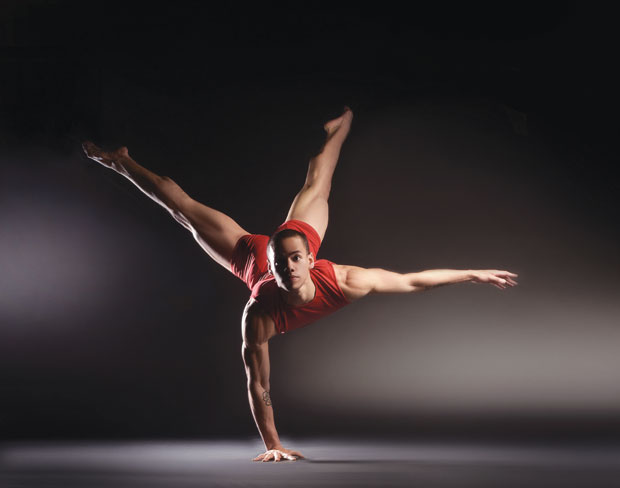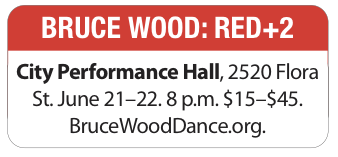Bruce Wood puts his dancers through their paces — and they love him all the more for it

BODIES IN MOTION | Albert Drake, a charter dancer with Bruce Wood Dance Project, specializes in executing the choreographer’s outrageous requests, knowing they ‘are going to hurt like hell at first.’ (Photo courtesy Brian Guilliaux)
ARNOLD WAYNE JONES | Life+Style Editor
“It’s hard to miss me when I’m next to women who are maybe 100 pounds,” Feril concedes.
Nevertheless, Feril seems as comfortable in his skin as more predictable dancers — and that’s largely because of the influence of Bruce Wood.
Wood’s own body is more typical of the ideal male form for modern dance and ballet, but his great talent as a choreography is creating unique works that surprise. And often those surprises come from his company itself.
“Being a guy dancer and choreographer, my point of view on guys is very different than, say, a female dancer or choreographer,” says Wood of his skill at exploring the beauty two men can create onstage together. “For one, guys can’t get away with any shit that I haven’t tried myself. And they simply deal with the floor differently, and each other differently. It goes on and on. The idea of what most folks think of as a ‘male dancer’ versus the reality — exemplified by the dance I did a few months ago [My Brother’s Keeper] — are very different.”
In the new production from the Bruce Wood Dance Project — his second this year, following My Brother’s Keeper in March — Wood revives one of his most popular pieces, Red, revisits his version of Rhapsody in Blue and debuts a world premiere, White Rabbit. And once again, his unique pairings imbue dance with a muscular beauty that resonates with gay audiences in particular.
“There are many interesting and eye-catching facets to duet, the fact that the two dancers are of the same gender is not one of them,” says Sean J. Smith, a member of Dallas Black Dance Theater since 2010 but a newcomer to BWDP. “But then again, I am from Canada.”

MAN TO MAN | Bruce Wood, rear, works out moves with dancers Albert Drake, back, and Ben Needham-Wood, front. (Photo courtesy Brian Guilliaux)
Although he only began dancing with Wood a month ago, Smith appreciation is long-standing.
“[DBDT] did a piece of his called Smoke [in 2010] and Bruce came back to add a new section. I grew fond of his beautiful choreography — and magnetic sarcasm — rather quickly. The only question I ask myself of someone’s work is, ‘Does this connect with people?’ It is obvious what the answer is in regards to Bruce’s work.”
Feril, who is straight (and, he notes, single), takes a nonchalant approach to Wood’s gender-bending pairing.
“Partnering with a man or a woman — doesn’t really matter to me either way,” he says. “When two men partner together the possibilities are completely different, the testosterone builds up and each man wants to be the one partnering rather than the one being partnered. Both roles are very important and teach each of the partners true trust, strength and caring. If [a duet] has a lot of grounded movement or shifting of weight from one to the other, I’d rather have another man on the other side of me catching me!”
Like Wood himself, Albert Drake took up dance late; at 22, he’s only be dancing for six years, but has been with BWDP since the beginning. Perhaps that newness is what has made Drake fearless in realizing Wood’s vision.
“I think my best strength [as a company member] is being able to do a lot of Bruce’s outrageous request when it comes to new choreography,” he says. “We know when it’s coming. He has this little smirk on his face and says, ‘You’re gonna hate me, but I need you to …’ It usually requires something that’s going to hurt like hell at first, but I can handle it. My smaller stature and strength allows me to be his test dummy for the day.”
Feril feels similarly devoted to executing Wood’s ideas. He first met Wood while attending Booker T. Washington High School, and says that experience was transformative. “I wanted to dance for Bruce; everything he said just clicked and made perfect sense. I can honestly say that Bruce Wood has shaped me into the man I am today, and without him in my life I wouldn’t be the strong male dancer from Grand Prairie that I am proud to say I am.”
The dancers are just as moved being in a BWDP production as audiences are seeing it.
“His understanding of phrasing and rhythm is overwhelmingly apparent, Smith says. “The way I feel watching his work is reminiscent of the way I felt watching Disney’s Fantasia as a child. It’s just the most beautiful visual depiction of the music beyond imagination.”
Adds Feril: “What I like most about Bruce’s work is that it connects with every living being, and its a community at work never one sole individual but its a well powered machine.”
Drake has his own take on why Wood’s choreography engenders such devotion.
“What I like the most about Bruce’s work is that I never know what’s going to happen!” he says.
“His vision is uniquely his own, and therefore, it isn’t until the entire work is completed that the veil to his brain is presented. It takes quite a bit of focus to keep up with him. Phrasing is constantly changing; ideas are constantly changing; unnecessary spectacles are tossed out. And when it comes to the end of that process, we’re left with this clear representation of human emotions and qualities. I love it.”
This article appeared in the Dallas Voice print edition June 21, 2013.


 At 6-foot-3 and 200 pounds, redheaded, freckle-faced 22-year-old Harry Nathan Feril isn’t what you’d call a “typical” male dancer. And he knows it.
At 6-foot-3 and 200 pounds, redheaded, freckle-faced 22-year-old Harry Nathan Feril isn’t what you’d call a “typical” male dancer. And he knows it.